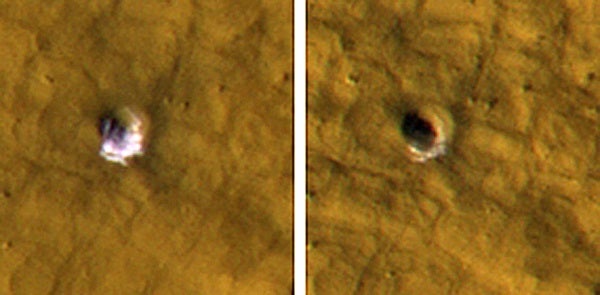NASA’s Mars Reconnaissance Orbiter has revealed frozen water hiding just below the surface of mid-latitude Mars. The spacecraft’s observations were obtained from orbit after meteorites excavated fresh craters on the Red Planet.
Scientists controlling instruments on the orbiter found bright ice exposed at five martian sites with new craters that range in depth from approximately 1.5 feet to 8 feet (half a meter to 2.5 meters). The craters did not exist in earlier images of the same sites. Some of the craters show a thin layer of bright ice atop darker underlying material. The bright patches darkened in the weeks following initial observations as the freshly exposed ice vaporized into the thin martian atmosphere. One of the new craters had a bright patch of material large enough for one of the orbiter’s instruments to confirm it is water-ice.
The finds indicate water-ice occurs beneath Mars’ surface halfway between the north pole and the equator, a lower latitude than expected in the martian climate.
“This ice is a relic of a more humid climate from perhaps just several thousand years ago,” said Shane Byrne of the University of Arizona, Tucson.
Byrne is a member of the team operating the orbiter’s High Resolution Imaging Science Experiment, or HiRISE camera, which captured the unprecedented images.
“We now know we can use new impact sites as probes to look for ice in the shallow subsurface,” said Megan Kennedy of Malin Space Science Systems in San Diego, member of the team operating the orbiter’s Context Camera.
During a typical week, the Context Camera returns more than 200 images of Mars that cover a total area greater than California. The camera team examines each image, sometimes finding dark spots that fresh, small craters make in terrain covered with dust. Checking earlier photos of the same areas can confirm a feature is new. The team has found more than 100 fresh impact sites, mostly closer to the equator than the ones that revealed ice.
An image from the camera August 10, 2008, showed apparent cratering that occurred after an image of the same ground was taken 67 days earlier. The opportunity to study such a fresh impact site prompted a look by the orbiter’s higher resolution camera September 12, 2009, confirming a cluster of small craters.
“Something unusual jumped out,” Byrne said. “We observed bright material at the bottoms of the craters with a very distinct color. It looked a lot like ice.”
The bright material at that site did not cover enough area for a spectrometer instrument on the orbiter to determine its composition. However, a September 18, 2008, image of a different mid-latitude site showed a crater that had not existed 8 months earlier. This crater had a larger area of bright material.
“We were excited about it, so we did a quick-turnaround observation,” said Kim Seelos of Johns Hopkins University Applied Physics Laboratory in Laurel, Maryland. “Everyone thought it was water-ice, but it was important to get the spectrum for confirmation.”
“This mission is designed to facilitate coordination and quick response by the science teams,” said Rich Zurek, Mars Reconnaissance Orbiter project scientist of NASA’s Jet Propulsion Laboratory, Pasadena, California. “That makes it possible to detect and understand rapidly changing features.”
The ice exposed by fresh impacts suggests that NASA’s Viking Lander 2, digging into mid-latitude Mars in 1976, might have struck ice if it had dug 4 inches (10 centimeters) deeper.










